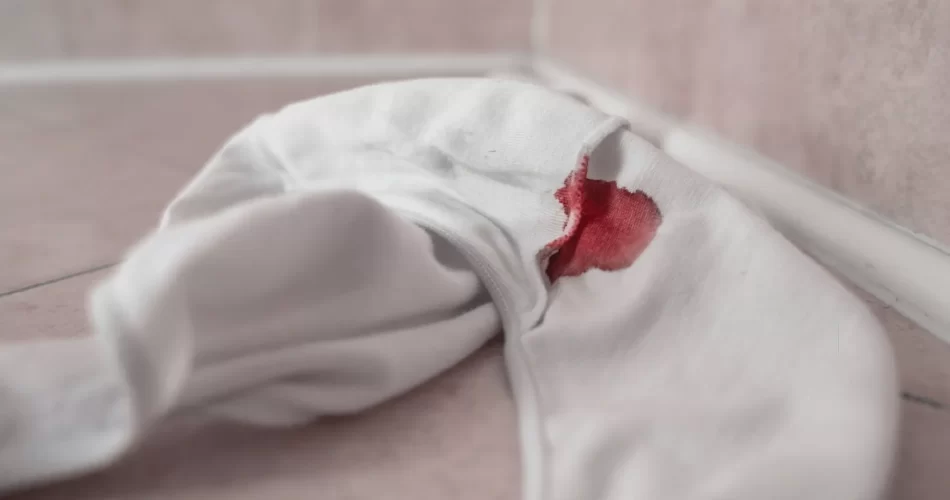Last Updated on 20 February 2024 by Vanessa Thoko
Implantation spotting is a small amount of light bleeding or spotting that can occur when a fertilized egg attaches to the lining of the uterus.
It typically happens 10 to 14 days after conception, around the time of your missed period.
Implantation bleeding is thought to be caused by the fertilized egg breaking down small blood vessels in the uterine lining as it implants.
It is usually light pink or brown in color, and it should last only a day or two.
Implantation bleeding is not as heavy as menstrual bleeding, and it should not be accompanied by clots.
In this post, we’ll take you through what implantation spotting is, how it differs from regular periods, and when you should pay attention to it.
Key Facts
- Implantation spotting is light bleeding when a fertilized egg attaches to the uterine lining.
- It typically occurs 10-14 days after conception, around the expected period time.
- It’s usually light pink or brown, lasting only a day or two and is lighter than a regular period.
- Recognizing implantation spotting is important – it may be accompanied by mild cramping.
- It can be hard to distinguish from a light period, but differences in color, flow, and duration can help.
- While usually not a concern, heavy bleeding or severe symptoms should prompt a doctor’s visit.
- Causes include hormonal changes, the embryo’s journey, and cervical adjustments.
- Implantation spotting is a rare occurrence in pregnancy, and it doesn’t repeat.
- If you experience heavy bleeding or pain, consult a healthcare provider.
- Embrace this natural part of early pregnancy on your journey to motherhood.
What Is Implantation?
Implantation is that magical moment when a fertilized egg attaches itself to the uterine lining.
This is where it all begins – your baby’s growth and development.
This process typically occurs about 6-10 days after ovulation, usually around the time your expected period would show up.
Understanding Implantation Spotting
Implantation spotting is a common early sign of pregnancy that occurs when a fertilized egg attaches to the lining of the uterus.
It is thought to be caused by the embryo breaking through the uterine lining as it implants.
Implantation spotting typically occurs 10 to 14 days after conception, around the time of your expected menstrual period
What Does Implantation Spotting Look Like?
Implantation spotting is usually light pink or brown in color, and it may be accompanied by mild cramping.
It is typically much lighter than a regular period, and it should not be heavy enough to soak through a pad or tampon.
Implantation spotting may last for only a few hours or up to a few days.
How To Tell If Implantation Spotting Or A Light Period?
It can be difficult to tell the difference between implantation spotting and a light period, especially if you have irregular periods.
However, there are a few things you can look for:
- Color: Implantation spotting is usually lighter in color than menstrual blood, and it may be pink, brown, or rusty. Menstrual blood is typically bright red.
- Flow: Implantation spotting is usually light and may only require a panty liner. Menstrual bleeding is typically heavier and may require a pad or tampon.
- Duration: Implantation spotting typically lasts for only a few hours to a few days. Menstrual periods typically last for 3 to 7 days.
- Other symptoms: Implantation spotting may be accompanied by other early pregnancy symptoms, such as breast tenderness, nausea, and fatigue. Menstrual periods are not usually accompanied by other pregnancy symptoms.
If you are unsure whether or not you are experiencing implantation spotting, it is always best to talk to your doctor.
They can perform a pregnancy test to confirm whether or not you are pregnant.
Is Implantation Spotting A Cause For Concern?
Implantation spotting is usually nothing to worry about. It is a normal part of pregnancy for many women.
However, if you experience heavy bleeding, cramping, or other severe symptoms, it is important to talk to your doctor right away.
These symptoms could be a sign of a miscarriage or other pregnancy complications.
Causes Of Implantation Spotting
- Hormonal Tango: Implantation involves a delicate dance of hormones. Your body is shifting gears to support the tiny newcomer.
- The Embryo’s Journey: The embryo’s journey to the uterine lining can sometimes cause minor irritation and result in spotting.
- Cervical Changes: Your cervix is undergoing some changes to accommodate the growing embryo, which can lead to spotting.
Recognizing Implantation Spotting
Signs to watch for include light bleeding, spotting, and sometimes mild cramping.
It’s often much lighter than your regular period, and the color is usually a pale pink or light brown.
It’s like a sneak preview of the big show.
Duration And Frequency
Implantation spotting typically lasts for only a few hours to a few days.
It is usually not heavy enough to soak through a pad or tampon, and it may come and go.
Implantation spotting is not a regular occurrence, and it is unlikely to happen more than once during a pregnancy.
When To Consult Healthcare Provider
While implantation spotting is typically harmless, it’s essential to keep an eye on it.
If the bleeding becomes heavy, you experience severe pain, or if you suspect any complications, don’t hesitate to reach out to a healthcare provider.
Your peace of mind is priceless.
Conclusion
Implantation spotting is a natural part of the early stages of pregnancy in South Africa and everywhere else.
By understanding this process, you can better navigate your journey to motherhood.
Keep an eye on the signs, embrace this magical moment, and remember that your body knows exactly what it’s doing.










